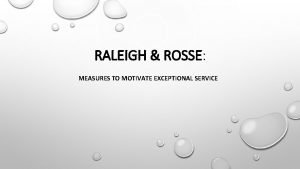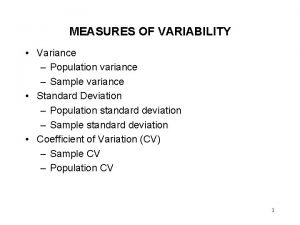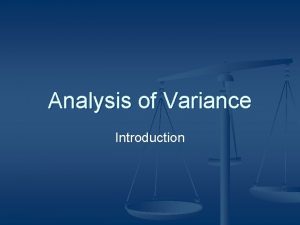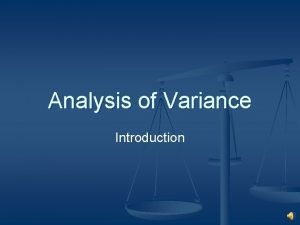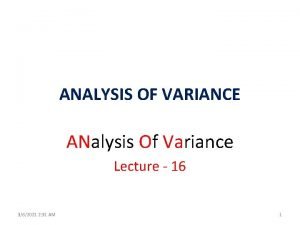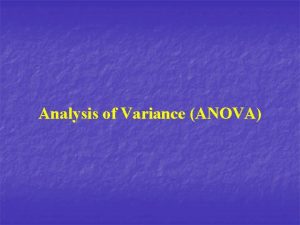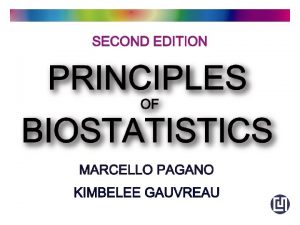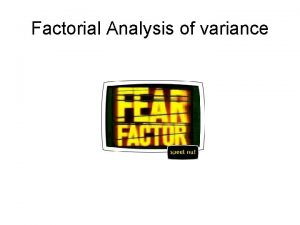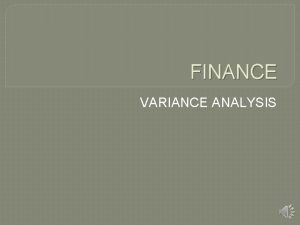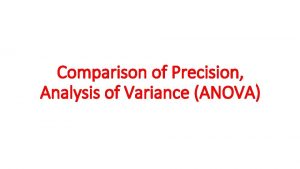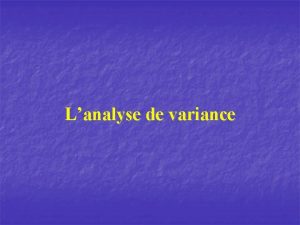Variance Analysis Agenda Motivate the need for variance
















- Slides: 16

Variance Analysis

Agenda • • • Motivate the need for variance analysis Describe the organizational use of variances Discuss the mechanics of variance analysis Example: Ross Parts Takeaway

Management Accounting Systems Cost Accounting Systems Budgeting Systems Variance Analysis Transfer Pricing Performance Measurement Systems

Variance Analysis • Organizations that have a budget typically compare the actual results to the budget at the end of the period. • Variance: Difference between actual and budgeted results: Actual Revenue: Budget Variance $1, 150 $1, 000 $150 F Direct Material: $450 $400 $50 U Direct Labor: $425 $450 $25 F Overheard: $100 $0 Profit $175 $50 $125 F

Labeling Convention – Variance that implies a higher profit: favorable (F) • Actual revenue is higher than budgeted • Actual costs are lower than budgeted – Variance that implies a lower profit: unfavorable (U) • Actual revenue is lower than budgeted • Actual costs are higher than budgeted

Goal of Variance Analysis Quantify the impact of the individual factors on the total variances Actual Budget Variance $1, 150 $1, 000 $150 F Sales volume, sales price Direct Material: $450 $400 $50 U Sales volume, material costs, material usage Direct Labor: $425 $450 $25 F Sales volume, labor costs, labor usage Overheard: $100 $0 Sales volume, resource costs, resource usage Profit $175 $50 $125 F - All of the above - Sales: Possible reasons for the variance

Purpose of Variance Analysis • Performance evaluation: • Who is responsible for the overall results? – How well did our sales/ marketing people do? – How efficiently did our production dept. use the resources? – How well did our sourcing dept. negotiate with suppliers? • Planning: • Should we change our product mix? • Should we change our suppliers?

Mechanics of Variance Analysis • We can quantify the impact of the individual factors by decomposing the variances: • The decomposition uses a common unit of measure, namely $ – It is difficult to compare #units, kg, $/unit, etc. , across products

Variance Analysis - Mechanics • We can quantify the impact of the individual factors by decomposing the variances: • Sales variance: Actual Sales (AV x AP) Flexible Budget (AV x EP) Output Price Variance (Master) Budget (EV x EP) Sales Volume Variance • Cost variances: Actual Costs (AO x AI x AP) (AO x AI x EP) Input Price Variance Flexible Budget (AO x EI x EP) Efficiency Variance (Master) Budget (EO x EI x EP) Production Volume Variance

Example: Ross Parts • Ross Parts produces the RP-24 • Budget for 2011: Per Unit Sales: Total: 100, 000 Units $20 $2, 000 Costs: Direct materials: 2 kg @ $3 = $6 $ 600, 000 Direct labor: 0. 2 hrs. @ $25 = $5 $500, 000 Overhead : Profit: $300, 000 $600, 000

Example: Ross Parts • Actual results for 2011: Total Sales: 100, 000 units @ $20. 50 $2, 050, 000 194, 000 kg @ $3. 50/kg $ 679, 000 21, 000 hrs. @ $23/hr. $483, 000 Costs: Direct materials: Direct labor: Overhead : Profit: $300, 000 $588, 000 Actual Direct Material usage per unit: 194, 000 kg/ 100, 000 units = 1. 94 kg/ unit Actual Direct Labor usage per unit: 21, 000 hrs. / 100, 000 units = 0. 21 hrs.

Example: Ross Parts • Sales variance (Volume is Sales Volume): Flexible Budget (AV x EP) Actual Sales (AV x AP) Price Variance 100, 000 x $20. 50 = $2, 050, 000 (Master) Budget (EV x EP) Volume Variance 100, 000 x $20 = $2, 000 Output Price Variance: $50, 000 F 100, 000 x $20 = $2, 000 Volume Variance: $0

• Cost variances (Volume is Production Volume): Actual Costs (AO x AI x AP) (AO x AI x EP) Input Price Variance Flexible Budget (AO x EI x EP) Efficiency Variance (Master) Budget (EO x EI x EP) Volume Variance Direct Material 100, 000 x 1. 94 x $3. 50 100, 000 x 1. 94 x $3 100, 000 x 2 x $3 = $679, 000 = $582, 000 = $600, 000 $97, 000 U $18, 000 F 0 100, 000 x 2 x $3 = $600, 000 Direct Labor 100, 000 x 0. 21 x $23 100, 000 x 0. 21 x $25 100, 000 x 0. 2 x $25 = $483, 000 = $525, 000 = $500, 000 $42, 000 F $25, 000 U 0 100, 000 x 0. 2 x $25 = $500, 000 Overhead $300, 000 “Spending Variance” $300, 000

Variance Decomposition Summary Sales variances Price variance Volume variance $50, 000 F $0 $50, 000 F Direct material variances Price variance 97, 000 U Efficiency variance 18, 000 F Volume variance $0 79, 000 U Direct labor variances Price variance 42, 000 F Efficiency variance 25, 000 U Volume variance Overhead Variance Profit Variance $0 17, 000 F $0 $12, 000 U Q: Why is this summary useful to management?

Takeaway • Variance: Difference between actual results and budget. • Variance Analysis: Quantitative decomposition of total variances into individual components (volume variance, price variance, cost variance, efficiency variance). • Purpose of variance analysis: – Performance evaluation: Who is responsible for the overall results? – Planning

Variance Analysis - Worksheet • We can quantify the impact of the individual factors by decomposing the variances: • Sales variance: Actual Sales (AV x AP) Flexible Budget (AV x EP) Output Price Variance (Master) Budget (EV x EP) Sales Volume Variance • Cost variances: Actual Costs (AO x AI x AP) (AO x AI x EP) Input Price Variance Flexible Budget (AO x EI x EP) Efficiency Variance (Master) Budget (EO x EI x EP) Production Volume Variance
 Raleigh and rosse case study solution
Raleigh and rosse case study solution How can employee involvement measures motivate employees
How can employee involvement measures motivate employees What is the difference between inspire and motivate
What is the difference between inspire and motivate Rational appeals focus on making or saving money
Rational appeals focus on making or saving money Set high expectations which inspire motivate and challenge
Set high expectations which inspire motivate and challenge Motivate interest
Motivate interest How to motivate esl students
How to motivate esl students Agenda sistemica y agenda institucional
Agenda sistemica y agenda institucional Material price variance formula
Material price variance formula Formuö
Formuö Typiska novell drag
Typiska novell drag Tack för att ni lyssnade bild
Tack för att ni lyssnade bild Ekologiskt fotavtryck
Ekologiskt fotavtryck Shingelfrisyren
Shingelfrisyren En lathund för arbete med kontinuitetshantering
En lathund för arbete med kontinuitetshantering Kassaregister ideell förening
Kassaregister ideell förening Personlig tidbok för yrkesförare
Personlig tidbok för yrkesförare
